In one way or another, all of us have been limited in what we can do with our dogs this year.
That’s why I decided to share how I’m keeping my dog Wally interested in walks around our neighborhood only.
These ideas are also helpful for when you just don’t have time to drive your dog to the park or trail but still want to get out for a walk in the neighborhood.
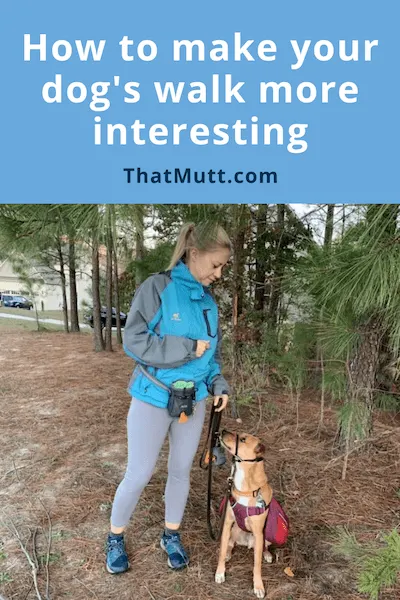
How reactive dogs benefit from current restrictions
I want to point out one of the benefits of our current 6-ft social distancing requirement! It actually comes in handy for reactive dogs.
That’s because people are paying a lot more attention to fellow doggie traffic in their neighborhoods now. I noticed that they’ll change the side of the road they’re walking on rather than insisting on having their dog “meet” other dogs they come across. So that’s a plus.
How to make your dog’s walks more interesting
Here are my ideas to make your dog’s walks more interesting around the neighborhood.
1. Change directions with your dog frequently
Changing directions frequently and unexpectedly while you’re out walking your dog will keep him interested in what his human is up to.
It’s also a great exercise for dogs who pull. When you notice that your pup reaches the end of the leash and creates tension you’re not willing to put up with, simply do a 180 and walk in the opposite direction.
You can repeat this exercise as often as necessary and add even more layers of interest by walking circles, number 8s, or anything else you can think of.
For more ideas, see: Teaching your dog to heel
Your pup will soon learn to pay attention to you and be curious as to where you’ll be headed next. Also think about wearing a treat pouch that you fill with his favorite, high-value training treats.
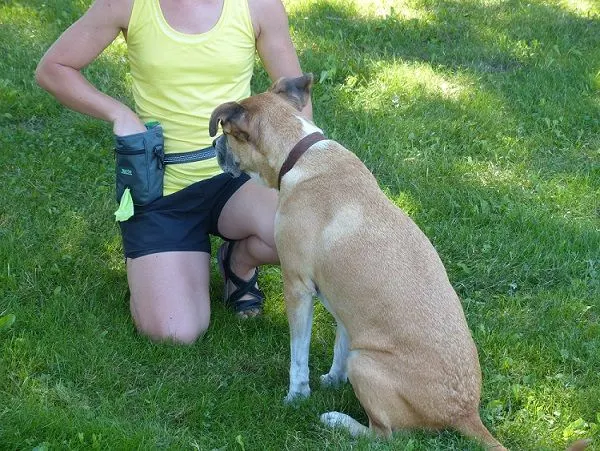
Hand treats out whenever he stays next to you and looks at you for direction, quite literally! Wally loves dehydrated green tripe treats and is very willing to perform for them, but anything stinky will do the trick.
2. Add a doggie backpack to keep walks interesting!
My next idea is the doggie backpack. It’s one of my all-time favorites and YES, you guessed it, of course Wally has one! As a matter of fact, he goes for doggie backpack walks almost every single morning with me.
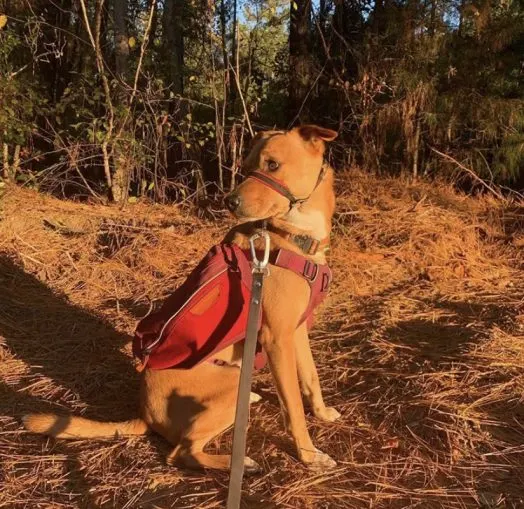
The moment I put his backpack on, he starts focusing on the job of wearing it. It features 2 side pockets, both of which I fill with toys or water bottles, extra poop bags and some treats.
Wally weighs 38 lbs and wears Ruffwear’s Commuter Pack in size small. Other brands that carry doggie backpacks are Outward Hound, One Tigris, Mountainsmith and a few others. Just do a search for doggie backpacks online. What I like is that they’re not just available for medium and large dog breeds, but also for smaller dogs.
I bought Wally’s backpack at an independently owned pet retail store, but you can also get them on Amazon and possibly Ebay for a good deal if you’re lucky. They run anywhere from $15-150.
See our post: Benefits of backpacks for dogs.
3. Incorporate obedience commands to keep your dog’s walks more interesting
I like to practice the following obedience commands to keep my dog’s walks more interesting, especially now that we’re restricted to our neighborhood:
Sit
Wally sits whenever we’re getting ready to cross a street. I also have him sit randomly and whenever he’s looking up at me. That’s followed by telling him what a good boy he is and a small treat.
Down
Wally lies down a few times for me when we’re out on a walk in our neighborhood, but it’s less frequently than I have him sit.
We practice both on the street as well as on grassy areas. I also reward him with both treats and verbal praise for lying down for me.
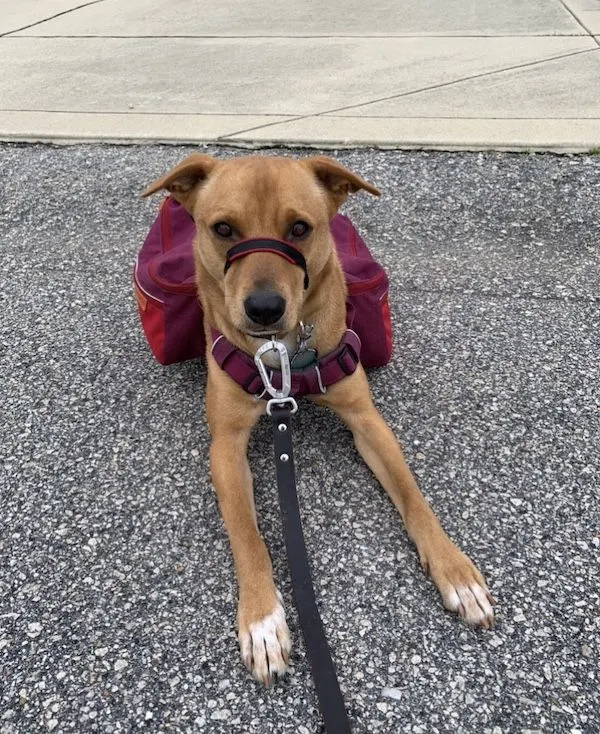
Stay
This is a favorite of mine! I’ll ask Wally to “sit,” followed by “stay” while I slowly walk around him. He usually stays put, which is when I’ll reward him with praise and a tasty treat. Also see my post: Teaching dogs to stay with distractions.
Leave it
I ask Wally to “leave it” when he shows interest in whatever trash or dog poop we come across. We use the same command when we spot a cat or rabbit on our walks and he wants to go after it!
It’s usually combined with walking in a 180 as it simply takes his visual focus off the animal. When he does “leave it” and looks at me instead, I reward with praise and a treat!
4. Carry a treat bag
All of these obedience commands are harder to do on a walk than in your living room because of all the distractions outside. That’s why it’s a good idea to carry your treat bag to help you get your dog’s attention. If you’re just starting out with obedience commands outside on walks, treat your pup often.
Get the Mighty Paw treat pouch here.
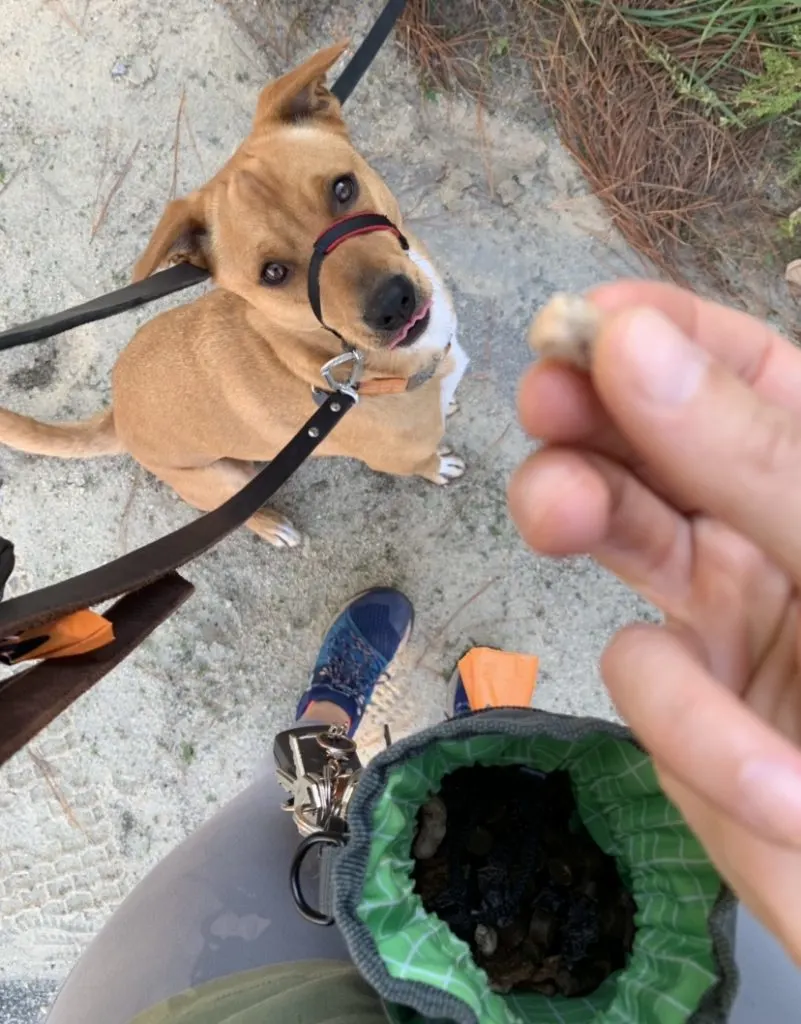
Eventually you’ll want to reduce the amount of treats you’re handing out. After all, those calories can add up quickly. You also won’t have to reward with food every single time your dog listens to you. Verbal praise goes a long way too!
However, high-value treats make obedience training easier at first and can also distract from the fact that you’re only walking around one area.
5. Practice tricks to make walks more fun!
Practicing tricks is a great way to keep your dog’s walks more interesting! The same concept applies to trick training as it does obedience training. Tricks require a lot more focus on your dog’s part when you’re asking him to obey outside rather than inside your home.
So far, Wally knows how to “shake” and how to “play dead” as far as tricks go. He will “shake” when out on walks but we actually haven’t practiced the “play dead” command yet while outside. Guess what we’ll start doing now 😉
That being said, trick ideas to practice outside on walks are:
Shake
You probably know this one as it’s a fairly common trick that involves your dog “shaking” your hand with her paw.
It’s easiest to ask for when your dog sits, but you can certainly make it more challenging by asking her to “shake” while she’s standing or even lying down outside.
Spin
The “spin” trick means that your dog turns around in a circle. You can either have your dog spin in any direction or up the ante by teaching him to turn left AND right on command.
Wally doesn’t know the “spin” command yet, but he actually does spin whenever he’s trying to get me to play with him. I’ll have to start adding the “spin” command whenever he does it naturally. That’s the easiest way of teaching a new behavior!
Crawl (on grass)
Another fun trick is the “crawl” trick. Have your pup practice his crawling skills while you’re out walking your neighborhood.
It’s best to do this on grass since the rough surface of asphalt or rocks can be damaging to the skin on his belly. Reward with praise and a treat when he’s crawled over to you!
Sit pretty
The “sit pretty” trick is a cuter version of the regular sitting position. It’s where your pup sits on his hind feet and lifts his front paws up parallel to the floor.
You can make the trick more challenging if you have your pup “sit pretty” on an elevated surface as well like on a bench or a tree stump.
This is easier for small and medium sized dogs than it is for larger pups, but they can learn it too.
I had taught it to my 75 lb Boxer mix Buzz, and while he wasn’t the most graceful doing it, he still looked adorable when he “sat pretty” on command.
Play dead (on grass)
When dogs perform the “play dead” trick, they fall over onto their side and stay put, ideally in a dramatic way! Wally knows this trick, but like I said before I have yet to practice it with him while we’re out on walks.
I’d also recommend doing this trick on a grassy area so that your pup won’t hurt himself when letting himself fall over on a rough surface.
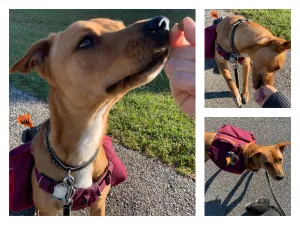
If you can think of any other tricks you’ve been practicing with your pup during walks, please share them in the comment section below this article! We’d love to read them.
6. Use obstacles to keep your dog interested
I’ve always made it a point to seek out any obstacles I encounter on walks with my pups, regardless of whether I walk in my neighborhood or at a park.
Not only are they great boredom busters and awesome for socializing purposes, they can also be used for trick-and obedience training. These obstacles can be natural or artificial ones, such as the following:
Tree stumps and logs
They’re usually not terribly high and make a great pedestal to perform a “sit” on. You can take it up a notch and have your pup do a “sit-pretty.” It’s great for core strength!
Or how about having your dog “sit-stay” next to the stump while YOU do a balancing exercise on it, like a Tree or Warrior Yoga pose?
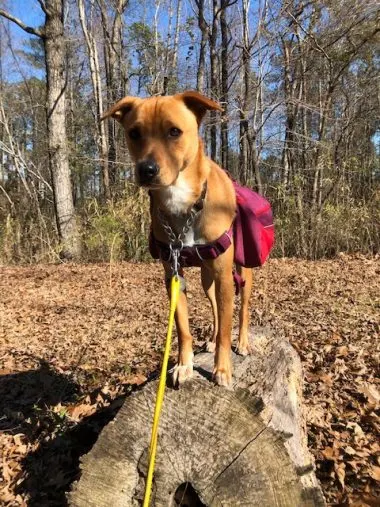
Wooden and Metal Benches
These are also great for core strength exercises. Have your pup put his front paws up on the bench and stay in place for 5-10 seconds when first starting out.
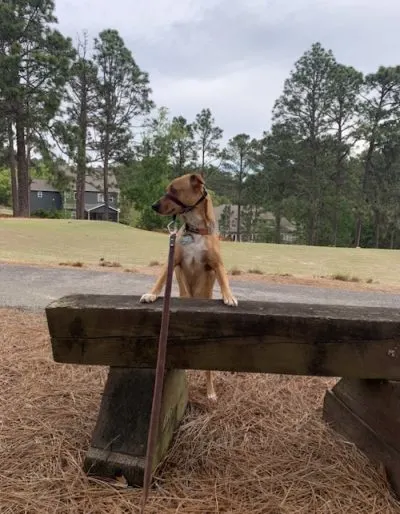
It’s also great for whole body awareness if you have her jump up on it and walk along the narrow surface.
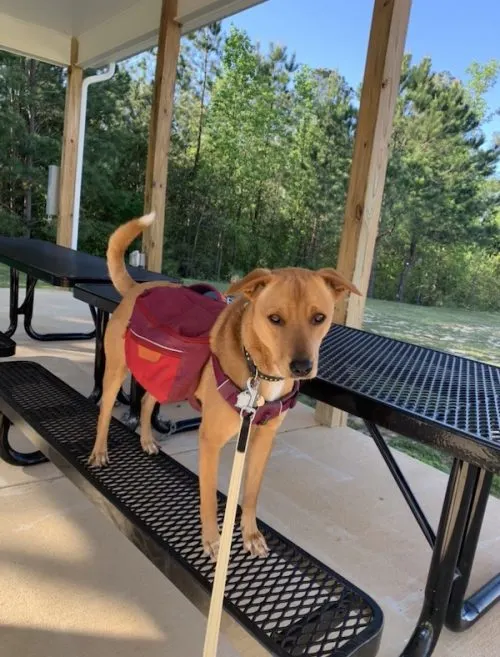
Construction cones and signs
These artificial obstacles are great for (ongoing) socialization to bulky and unusual objects. If your pup is shy around them, bring some high-value treats along and place them on the cone or sign or whatever else it might be.
That’ll help create a positive association with the object and make her look forward to seeing it again on future walks!
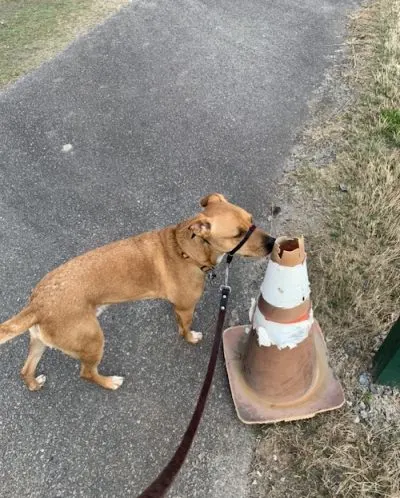
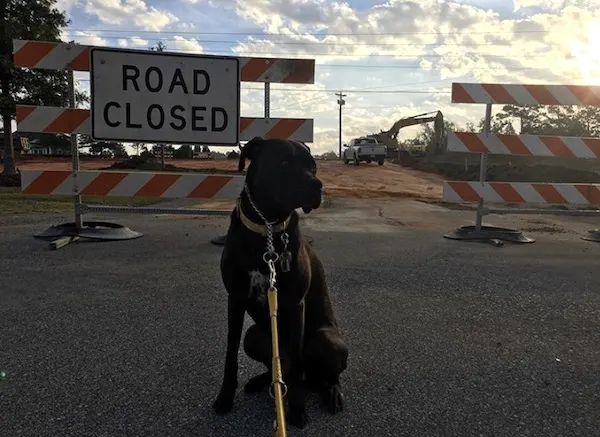
I’ve also come across the occasional shopping cart in the various neighborhoods I’ve lived in, and always used them for socializing and obedience training purposes!
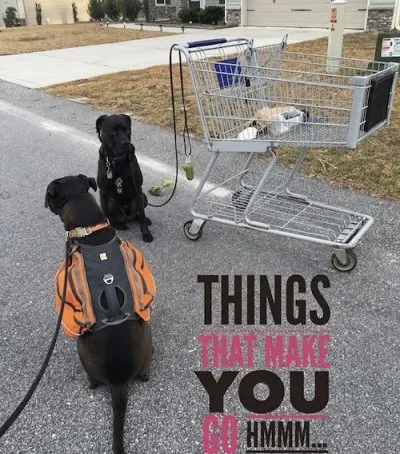
7. Alternate the speed at which you explore your neighborhood
This tip is all about how (fast) you walk through your neighborhood! Obviously it’ll depend on you and your dog’s fitness level, age, and overall health. Try some or all of the following:
- Walk faster.
- Jog.
- Bike.
- Rollerblade.
- Skateboard.
Wally and I walk at different speeds (together), and we also go for bike rides. I haven’t tried rollerblading with him yet because there’s a good amount of little hills in my neighborhood, and my rollerblading skills aren’t the best.
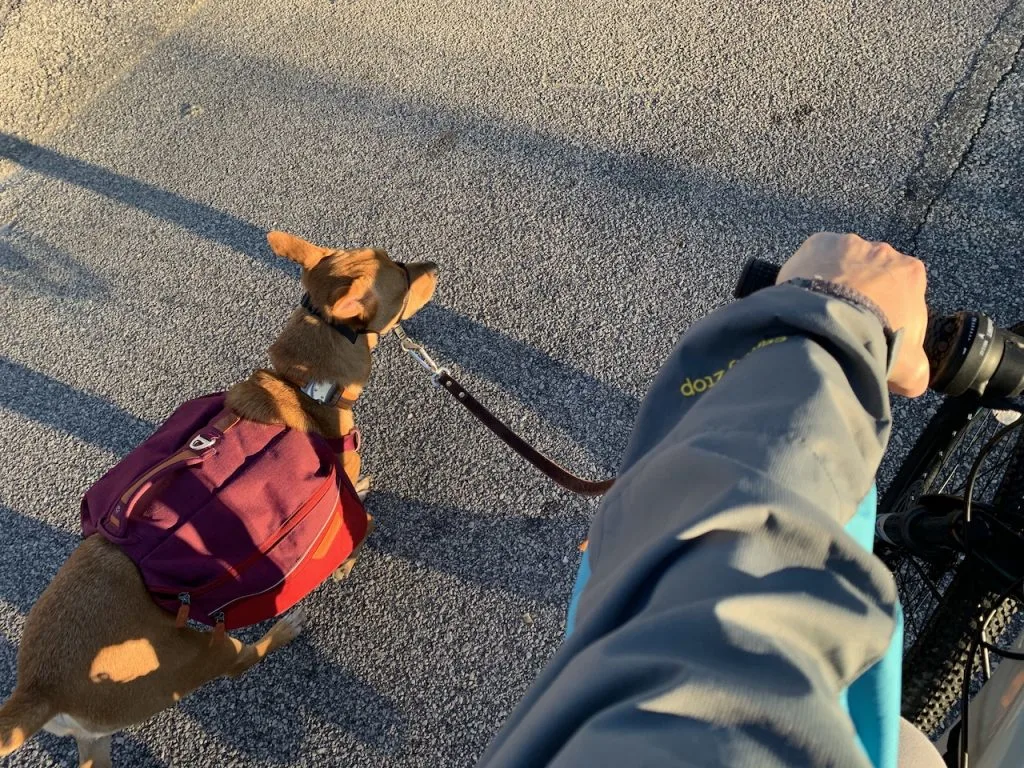
I made sure to socialize Wally to my bike for a few days before I started biking with him. My bike would just sit on my back porch where Wally could see it, sniff it, and hang out next to it. The bike definitely makes my dog’s walks more interesting!
See That Mutt’s article 10 Tips for Biking With Your Dog if you’re interested in learning more about the topic.
Now we’d like to hear from you!
Now it’s your turn! Do you have any additional tips on how to keep your dog’s walks more interesting?
If you have any questions, let us know in the comments!
Barbara Rivers writes regularly for That Mutt. She is certified in raw dog food nutrition from Dogs Naturally Magazine and the author of three ebooks about balanced raw dog food. She is a blogger at K9s Over Coffee.

Diane Barnes
Sunday 17th of May 2020
I like to take my dog shopping with me to dog-friendly stores like Home Depot. It is very good training for heel with lots of change in direction. Also good for socialization, because many of the employees carry pet treats in their pockets.
Siddhika
Tuesday 21st of April 2020
Hi, I really like a lot of points mentioned in your post like including impulse control and focus building training commands, changing directions, trees and logs etc. Daily walks can get pretty mundane, so adding these variations can certainly spark things up.